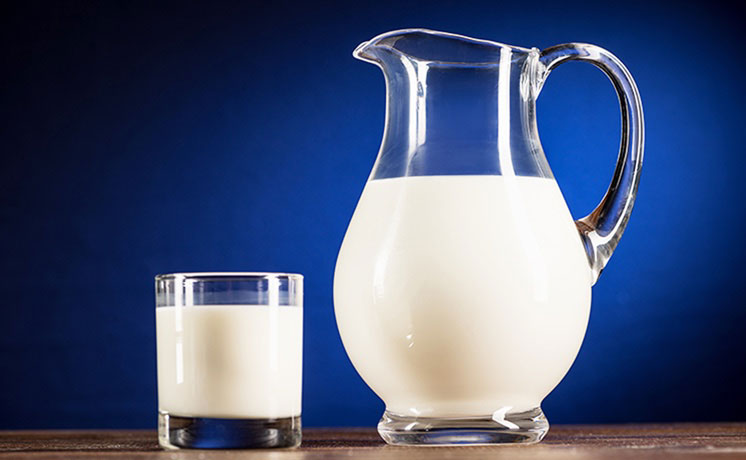REAL® Dairy Nutrition Information
The 9 Essential Nutrients
In REAL® Milk
Why should you choose REAL® dairy products? Because REAL® milk, cheese and yogurt offer a unique package of nine essential nutrients that both children and adults need to stay healthy:3
- Protein, to build and repair muscle tissue
- Calcium, for strong bones and teeth
- Vitamin A, for healthy skin and eyes
- Vitamin D, to facilitate immune health and bone strength
- Vitamin B12, for blood function and nervous system health
- Phosphorus, for tissue growth and strong bones and teeth
- Riboflavin (B2), to break down nutrients for energy
- Niacin (B3), for a healthy metabolism
- Pantothenic Acid (B5), to break down nutrients for energy

“Non-dairy beverages are not able to completely mimic the nutritional profile of cow’s milk.”
— Vandana Sheth, RDN, CDE, spokeswoman for the Academy of Nutrition and Dietetics1

REAL® Dairy Is Good For Your Heart
REAL® dairy foods benefit your body in unseen ways. In adults, research shows that consuming up to three servings of dairy each day is associated with lower blood pressure, which reduces the risk of cardiovascular disease, the leading cause of death in the U.S.4,5,6,7 That’s why it’s crucial to look for the REAL® Seal to ensure you’re buying genuine, natural dairy products with the right nutritional content. Your heart will thank you.

Why Kids Need REAL® Dairy
REAL® dairy is an excellent source of calcium, potassium and vitamin D—major nutrients in which children are commonly deficient.8 A diet that's low in REAL® dairy can have serious consequences for kids. Inadequate calcium levels can increase the risk of osteoporosis and life-threatening fractures later in life.9 And, according to a study published in 2017, children who drink imitation dairy beverages tend to be shorter than those who drink REAL® milk.10 Kids need REAL® dairy because it supports healthy growth. Experts recommend that children consume two to three servings of low-fat or fat-free dairy products daily as part of a healthy diet.11
“The protein and fat content of non-cow milk beverages is highly variable. Children who consume non-cow milk may receive less dietary protein and fat than children who consume [cow’s] milk."
— Marie-Elssa Morency et al., MSc, Nutritional Sciences, University of Toronto Department of Nutritional Sciences2

REAL® Dairy: The Best Food For Healthy Bones
REAL® dairy foods play a major role in keeping your bones healthy. After all, bones are living, dynamic tissues that need the support of nutrients to stay strong.12 Dairy products are rich in calcium, vitamin D and phosphorus, which are essential for bone maintenance. By consuming three servings of low-fat or fat-free dairy products daily, adults can help keep their bones healthy for life.13
REAL® Solutions For Lactose Intolerance
Lactose intolerance causes many people—especially children and members of certain ethnic groups—to avoid dairy. But there are REAL® dairy solutions that still provide the essential nutrients you won’t get from imitation dairy products. Experts recommend trying REAL® yogurt, natural cheeses or lactose-free or reduced-lactose milk to get your daily servings of REAL® dairy.14,15,16
The live bacterial cultures in yogurt may provide lactase, an enzyme that helps your body break down lactose.17 And many cheeses are naturally low in lactose, since lactose is found in the whey portion of milk, and most of the whey is removed during the cheesemaking process.
By choosing the right REAL® dairy products, lactose intolerant people can ensure they get the nutrition they need.
Learn more about
how REAL® dairy
outshines imitation products
See Comparisons






REFERENCES
1 CNN, “Non-dairy beverages like soy and almond milk may not be ‘milk,’ FDA suggests,” July 19, 2018,
https://www.cnn.com/2018/07/19/health/fda-soy-almond-milk-trnd/index.html.
2 The American Journal of Clinical Nutrition, “Association between non-cow milk beverage consumption and childhood height,” June 7, 2017,
https://doi.org/10.3945/ajcn.117.156877.
3 U.S. Dept. of Agriculture, Agricultural Research Service, FoodData Central, “Milk, low-fat, fluid, 1% milk fat, with added vitamin A and vitamin D,”
https://fdc.nal.usda.gov/fdc-app.html#/food-details/322228/nutrients.
4 American Heart Association, “Heart Disease and Stroke Statistics––2012 Update,” Dec. 15, 2011,
https://www.ahajournals.org/doi/10.1161/CIR.0b013e31823ac046.
5 The New England Journal of Medicine, “A clinical trial of the effects of dietary patterns on blood pressure,” April 17, 1997,
https://www.nejm.org/doi/full/10.1056/NEJM199704173361601.
6 National Heart, Lung and Blood Institute, “In Brief: Your Guide to Lowering Your Blood Pressure With DASH,” Dec. 2006,
https://www.nhlbi.nih.gov/files/docs/public/heart/dash_brief.pdf.
7 American Heart Association, “Heart Disease and Stroke Statistics–2016 Update,” Dec. 16, 2015,
https://www.ahajournals.org/doi/full/10.1161/CIR.0000000000000350.
8 Nutrients, “Food Sources of Energy and Nutrients among Children in the United States: National Health and Nutrition Examination Survey 2003-2006,” Jan. 22, 2013,
https://www.mdpi.com/2072-6643/5/1/283.
9 Pediatrics, “Perceived milk intolerance is related to bone mineral content in 10-to-13-year-old female adolescents,” Sept. 2007,
https://www.ncbi.nlm.nih.gov/pubmed/17766507.
10 The American Journal of Clinical Nutrition, “Association between non-cow milk beverage consumption and childhood height,” June 7, 2017,
https://doi.org/10.3945/ajcn.117.156877.
11 U.S. Dept. of Health and Human Services and U.S. Dept. of Agriculture, “2015-2020 Dietary Guidelines for Americans,” Dec. 2015,
https://health.gov/dietaryguidelines/2015/guidelines/.
12 Osteoporosis Int., “The National Osteoporosis Foundation’s position statement on peak bone mass development and lifestyle factors: a systematic review and implementation recommendations. Feb. 8, 2016,
https://www.ncbi.nlm.nih.gov/pubmed/26856587.
13 U.S. Dept. of Health and Human Services and U.S. Dept. of Agriculture, “2015-2020 Dietary Guidelines for Americans,” Dec. 2015,
http://health.gov/dietaryguidelines/2015/guidelines/.
14 Journal of the National Medical Association, “Lactose intolerance and health disparities among African Americans and Hispanic Americans: an updated consensus statement,” 2013,
https://www.ncbi.nlm.nih.gov/pubmed/24079212.
15 Journal of the National Medical Association, “Overcoming the barrier of lactose intolerance to reduce health disparities,” Feb. 2002,
https://www.ncbi.nlm.nih.gov/pubmed/11853047.
16 Pediatrics, “Lactose intolerance in infants, children, and adolescents,” Sept. 2006,
https://pediatrics.aappublications.org/content/118/3/1279.
17 The American Journal of Clinical Nutrition, “Lactose digestion from yogurt: mechanism and relevance,” April 2, 2014,
https://academic.oup.com/ajcn/article/99/5/1251S/4577509.